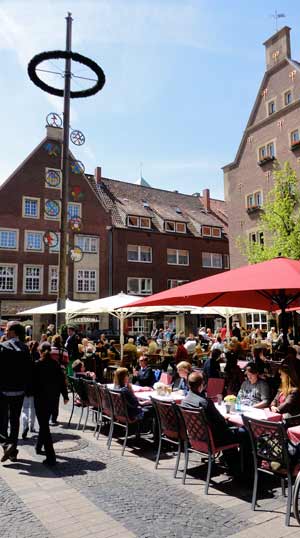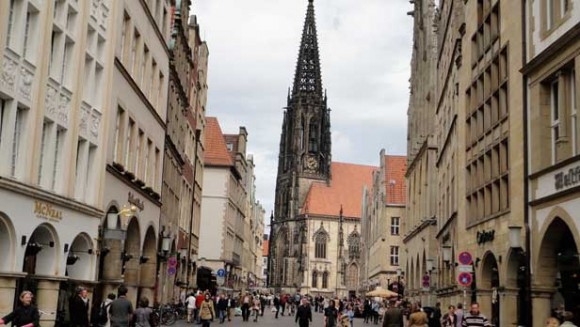by John Thompson
Münster is a great place to go on a long weekend. In two full days you will have time to shop, eat, drink and see the sights. Although Münster was heavily bombed during WWII, it has been beautifully reconstructed in the old style.
The city of Münster has a population of about 300,000 and is the bicycle capital of Germany. During the Middle Ages, it played a major role in the Hanseatic League. It is famous for the Anabaptist Rebellion of 1533-34 and for its role as the location of the signing of the Peace of Westphalia in 1648, which ended the 30 Years War. Münster also has a major university, which hosts more than 40,000 students.
 Must-see destinations include:
Must-see destinations include:
1. Prinzipalmarkt. This is a long pedestrian area (like a little shopping mile) lined on both sides with quaintly gabled buildings. You can take your pick from the almost unlimited categories of products sold in one-of-a-kind boutiques, or you can sit outdoors and soak up the sunshine with a cappuccino or one of their well-known local beers.
2. The Rathaus (Town Hall) is located on the Prinzipalmarkt. It is famous as the location where European nobility met to sign the Peace of Westphalia, ending the infamous 30 Year War. Fought mainly in what is now Germany, this was the longest conflict of the modern era and, in the end, involved almost every power in Europe. Entry to the Friedensaal (Hall of Peace) is €2 per person, Tue-Fri 10 a.m. to 5 p.m., Sat-Sun 10 a.m. to 4 p.m.
3. Pablo Picasso Museum. This small but interesting museum contains some important works of Picasso. Entry: €10 per person. Kids up to 6 are free. Kids 16 and under cost €4.00. Open daily 10 a.m. to 6 p.m.
4. Wochenmarkt Münster (Münster’s Weekly Market). This takes place on the Domplatz every Wed and Sat til 2:30 p.m. You can visit this fabulous market, one of the best in Germany. Fresh fruits and vegetables of all kinds, cheeses, flowers, fresh bread – even Dutch licorice – are all available to taste…before you buy. Visited regularly by many of the local inhabitants of Münsterland, this market is often crowded.
5. Münster Cathedral (Dome of St. Paul). Located on the highest hill in Münster and right next to the Prinzipalmarkt, this Cathedral is a great choice for a visit since it is so close to the other sightseeing recommendations. Originally build in the 8th century, it was rebuilt after a fire in the 13th century. The astronomical clock and organ can be seen inside the church after the renovation is complete.
6. St. Lamberti’s Church. Located on the north end of the Prinzipalmarkt, this church is famous for the three iron cages that can still be seen hanging from part of the steeple. These iron cages once contained the tortured and executed bodies of the leaders of the Anabaptist Rebellion of 1533-34. There is no cost to enter the church to view the large organ, colored windows and huge decorated ceiling.
7. Stadtmuseum (City Museum). It is free to visit and contains a detailed description of Münster’s history, along with reproductions, great old photos, written descriptions, archeological samples – which will be really enjoyable if you are interested in the historical aspects of the city and region.
Münster is a great place to go on a long weekend. Put this on your travel calendar to enjoy your time in Germany!
Getting there
By car, Münster is about 4 hours from Kaiserslautern, 5 hours from Stuttgart, and 3 hours from Wiesbaden. Visit the Deutsche Bahn website for train details.








